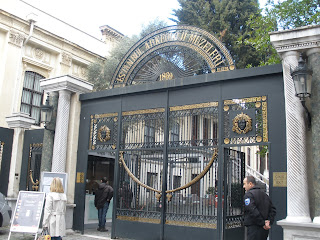Istanbul Archaeology Museum was established in 1869 by Osman Hamdi Bey. He directed the building of three buildings, which now are all exhibit space, as well as the surrounding garden.
The most ornate building houses the ceramic collection, including pieces...
made by the Seljuks, who inhabited Anatolia 10-13th century.
The main building houses artifacts excavated in the vast geography of the Ottoman empire.
Small tablets displaying contracts are some of the oldest artifacts. This clay tablet, about 2 inches by 2 and 1/2 inches is written in the Old Assyrian dialect from the 19th century B.C. For those unable to translate your own, the contract states:
"Ahatutum bought the daughter of Hana and paid half-a-mina and 1 1/2 shekels of silver. If Hana seizes her daughter, she will pay 1 mina of silver and take her daughter home. If, someone else seizes her, then Hana will seize Ahatutum. If, she makes improper things and behaves badly, she will sell her wherever she wishes. Two witnesses"
So, how much money in today's currency, did Hana receive for her daughter? To help with that problem, 1 mina weighs about 500 grams and 1 shekel weighs about 8 grams.
While you are working on that math problem, here are some bead molds, ...
and some beads, not made from the above molds.
The museum has so much to see, so for the balance of the pictures on this post, we have lions. One in mosaic, ...
one from the Roman period (30 BC - 395 AD), ...
one of a pair from the Neo-Babylonian Nebuchadnezzar II period (604-562 BC), ...
Babalonian tiled lion, ...
and one portal lion from the Hittite period (8th century BC).
This is barely the tip of the iceberg, which is the Istanbul Archaeology Museum. For glass lovers, a separate post of Roman period glass will be forthcoming.
At today's rate of precious silver, Hana would have received about $280 (USA) for her daughter. For this nugget of history, we owe her so much more than that!












No comments:
Post a Comment